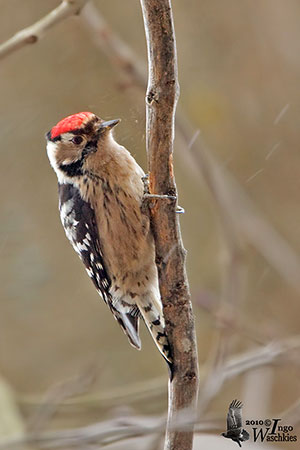
Fr: Pic épeichette
Ang: Lesser Spotted Woodpecker
All: Kleinspecht
Esp: Pico Menor
Ita: Picchio rosso minore
Nd: Kleine Bonte Specht
Sd: mindre hackspett
Photographers:
Didier Buysse
Vision d’Oiseaux
Jean-Claude Jamoulle
A la rencontre des Oiseaux
Françoise Vareille
Ingo Waschkies
Bird Photography
Nicole Bouglouan
Photographic ramble
Text by Nicole Bouglouan
Sources:
HANDBOOK OF THE BIRDS OF THE WORLD Vol. 7 by Josep del Hoyo-Andrew Elliott-Jordi Sargatal – Lynx Edicions – ISBN: 8487334377
WOODPECKERS, an identification guide of the woodpeckers of the world by Winkler Hans and Christie David – Helm – ISBN: 0395720435
THE HANDBOOK OF BIRD IDENTIFICATION FOR EUROPE AND THE WESTERN PALEARCTIC by Mark Beaman, Steve Madge - C.Helm - ISBN: 0713639601
THE COMPLETE BOOK OF BRITISH BIRDS – Written by “Royal Society for the Protection of Birds” experts - Préface de Magnus Magnusson - Michael Cady- Rob Hume Editors - ISBN: 0749509112
BIRDS OF THE MIDDLE EAST by R.F. Porter, S. Christensen, P. Schiermacker-Hansen - C.Helm - ISBN: 0713670169
What Bird-The ultimate Bird Guide (Mitchell Waite)
Wikipedia, the free encyclopaedia
Lesser Spotted Woodpecker
Dryobates minor
Piciformes Order – Picidae Family
INTRODUCTION:
The Lesser Spotted Woodpecker is the smallest European woodpecker and is about the size of the House Sparrow.
The range of this woodpecker is the Palearctic region, and depending on the authors, 11-13 subspecies share the wide distribution.
The Lesser Spotted Woodpecker frequents deciduous and mixed forests and woodlands in lowlands, mainly open forests near lakes and rivers, but it is also observed at forest edge and in orchards, parks and gardens. It needs soft wood trees for nesting.
It feeds on small insects, but caterpillars, other arthropods and spiders are also part of the diet.
Like most Picidae, it nests in a cavity excavated by both mates, between 2 and 8 metres above the ground, in tree trunk or on the underside of a dead limb. It is usually difficult to find. Both parents share the nesting duties.
The Lesser Spotted Woodpecker is affected by habitat loss and forest fragmentation, involving local declines in Europe. But currently, the species is not globally threatened.

DESCRIPTION OF THE BIRD:
Biometrics:
Length: 14-16 cm
Weight: 16-26 g (depending on the subspecies)
The Lesser Spotted Woodpecker adult male has black upperparts with broad, white bars on lower mantle and lower scapulars to upper rump. The black wing-coverts show white markings (spots and bars) near the tips. The flight-feathers are black with broad white bars. The uppertail is black but the outer rectrices are white and show 2-3 blackish bars near the tips.
The underparts are white, slightly tinged buff. Sides of breast and flanks are finely streaked black. The undertail-coverts are often spotted black.
On the head, forehead and lores are tinged buff. The crown is crimson-red, bordered by narrow black line. Nape and hindneck are black. Rest of head is white, including chin and throat. We can see a black malar stripe extending on neck side and irregularly down to upper side of breast.
The short, chisel-shaped bill is dark grey, sometimes blackish. The lower mandible has pale base. The eyes are dark brown or red-brown. Legs and feet are greenish-grey.
The female resembles male but she lacks the red crown which is white with tinged buff forecrown.
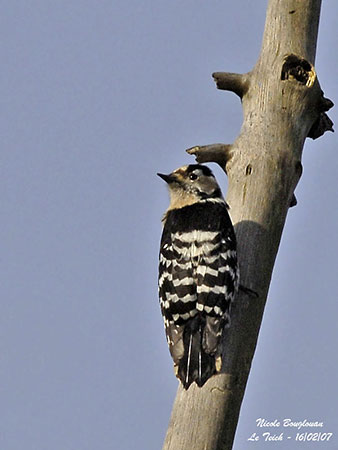
P. m. buturlini
Female
The juvenile is duller. The black areas of the plumage are tinged brown. The pale feathers of the forehead have dark tips. On the underparts, the streaking is heavier but duller.
The young male has purplish-red forecrown with greyish mottling, whereas the young female has pale forecrown with dark-tipped feathers and some reddish tips.
SUBSPECIES AND RANGE:
The global range of the Lesser Spotted Woodpecker is the Palearctic region. The range is immense, extending from West Europe, including Britain in W, through Russia to Kamchatka and E Siberia in the East.
It usually reaches N Africa in South, and the southern limits otherwise Eurasia from Spain through Anatolia, the Caucasus, Iran, Mongolia and Manchuria to North Korea and Japan (Hokkaido).
Depending on the authors, the Lesser Spotted Woodpecker has 11 or 13 subspecies. Populations intergrade in many parts of the range. They differ in size, pattern and darkness of the plumage. But there are numerous intermediate populations.
Northern races:
P. m. minor (Scandinavia and N Continental Europe, east of Baltic, to Urals). Described above.
P. m. kamtschatkensis or immaculatus (Urals east to Kamchatka and Anadyr River. The largest race.
P. m. amurensis (lower Amur River, Ussuriland, NE Manchuria, NE Korea, Sakhalin and Hokkaido. Very like nominate.
Southern races:
P. m. hortorum (from France east to Poland and south to Hungary and Switzerland. This one has slightly less white on
back than minor.
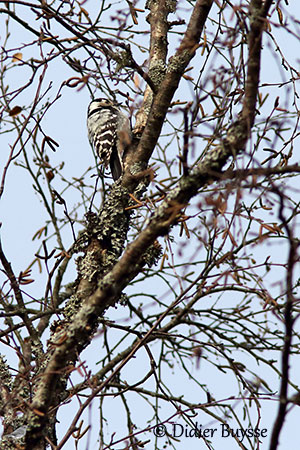
P. m. minor
Female
CALLS AND SONGS: SOUNDS BY XENO-CANTO
The Lesser Spotted Woodpecker gives a weak, shrill, repeated “kee kee kee kee…” or “pee pee pee pee…” recalling the Eurasian Wryneck or the Common Kestrel. This call is often slowing towards the end. It is given to advertise the territory.
We can also hear sometimes a short, sharp contact call “pik” or “chik” weaker than that of the Great Spotted Woodpecker.
Drumming is frequent and may last 1,2/1,6 seconds. Both adults drum, usually from high in the crown of a tree. Drumming is often interspersed with series of calls at peak of courtship displays.
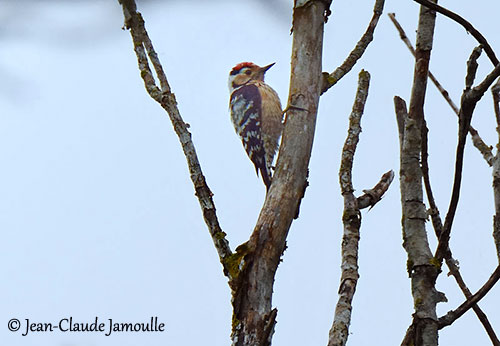
BEHAVIOUR IN THE WILD:
The Lesser Spotted Woodpecker feeds on small insects caught high in the canopy among the smallest branches, but also in dense vegetation. It probes the branches for insects and larvae, especially adults. But it also consumes ants, flies, aphids and moths. The long tongue is used to reach and extract invertebrates from bark and wood crevices. The powerful bill allows the bird to peck into dead and rotten wood.
During winter, it feeds mainly on wood-boring larvae and those living under the bark, including longhorn beetles adults and larvae while foraging on dead branches. It may also take occasionally fruit and berries, and seeds at bird feeders.
The Lesser Spotted Woodpecker feeds by gleaning, hammering, pecking series with a rapid sewing machine-like action of the bill, to dislodge pieces of bark and reach the food items. It also performs aerial sallies for insects. It may hang upside- down on outermost twigs. It creeps and hops along branches with the body parallel to the branch. It often forages alone but it may join mixed-species flocks outside breeding season, and especially tits of family Paridae.
P. m. buturlini
Female
The Lesser Spotted Woodpecker performs conspicuous butterfly-like display flights accompanied by “pee…pee…pee…” advertising calls. Both mates also drum on trees, usually from the crown of a tree. Drumming is used to proclaim the territory and warn off rivals.
The displays involve wing-spreading and tail-spreading, and a typical flutter-aerial display and gliding flights with the wings held well above the back.
The Lesser Spotted Woodpecker nests in a cavity excavated by both adults, often on the underside of a dead limb. They are monogamous with long term pair bonds, often over several years.
P. m. buturlini
Near the nest cavity
P. m. buturlini (Iberia, southern France, Italy, Greece and Romania). It is smaller and shorter-tailed than nominate.
P. m. ledouci (NW Africa - NE Algeria and NW Tunisia). Very similar to the previous, especially the Iberian population.
P. m. comminutus (Britain). Slightly smaller than buturlini.
P. m. danfordi (Greece and Turkey). Very like buturlini but slightly browner below.
P. m. colchicus (Caucasus and Transcaucasia, except Lenkoran region). This race is slightly bigger than danfordi and has more white above
P. m. quadrifasciatus (Lenkoran area of SE Transcaucasia). Small and short-billed, and very similar to buturlini.
P. m. morgani orhyrcanus(NW Iran and Zagros mountains). A highly distinctive race with very long, narrow bill.
Depending on the authors, the races immaculatus (very white on back and underparts, and unmarked below) and hyrcanus (intergrades with colchicus in NW Iran) are sometimes separated.
HABITAT:
The Lesser Spotted Woodpecker frequents mature deciduous woodlands with old rotting trees used for nesting. But this species is also observed in orchards and parks where old trees are present, forest edge and sometimes gardens. It usually prefers deciduous open forest in lowlands near lakes or rivers.
It is generally present in lowlands and foothills to 850 metres of elevation, locally to 1260 metres in Europe. However, it is found at higher elevations in Asia, between 1400 and 2000 metres, and 1300 metres in N Africa.
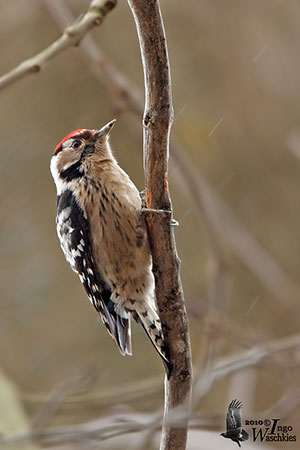
It is usually resident throughout the wide range. Only the northern populations are partly migratory, and the N European birds may reach C Europe and Black Sea.
The flight action is rather weak and fluttering over short distances. However, when the bird is well underway, the flight becomes more determined and strongly undulating, alternating several rapid wingbeats and short glides.
REPRODUCTION OF THIS SPECIES:
The laying takes place from April to mid-May, and to June in N of the range. The courtship displays start in February.
The Lesser Spotted Woodpecker prefers deciduous forest for nesting, but it may occur in suburban habitats such as parks and gardens. Due to its small size and small bill, it uses softer trees and branches with smaller diameter for the nest hole than other larger woodpeckers. Within the habitat, dead and decayed deciduous trees with dead parts and branches are important for the Lesser Spotted Woodpecker throughout its range.
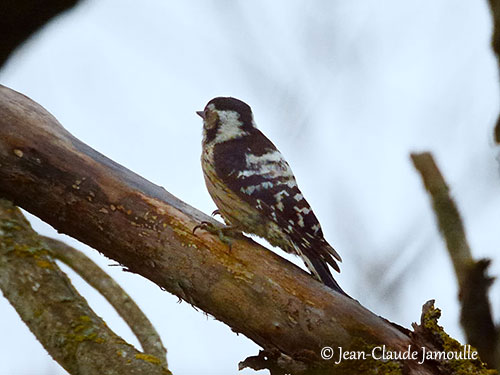
P. m. buturlini
Female
Courtship activities begin in February. Both male and female excavate the nest. This work may last from 6 days to 2-4 weeks. The holes (nest and roost) are made in the soft wood of dead or decaying tree trunk or on the underside of a branch. The nest is placed mostly from 2 to 8 metres above the ground, sometimes up to 20 metres in deciduous tree species.
The copulation occurs close to the nest, often interspersed with cavity excavation. The entrance hole is about 3/3,5 centimetres in diameter, and the depth of the cavity varies from 10 to 18 centimetres.
The female lays 5-6 (4-9) glossy white eggs. Both adults share the incubation during 10-12 days, and the male is often more present than the female. It usually roosts in the nest.
The chicks are fed by both parents and fledge about 18-21 days after hatching. The young birds still depend on parents for 1-2 weeks more.
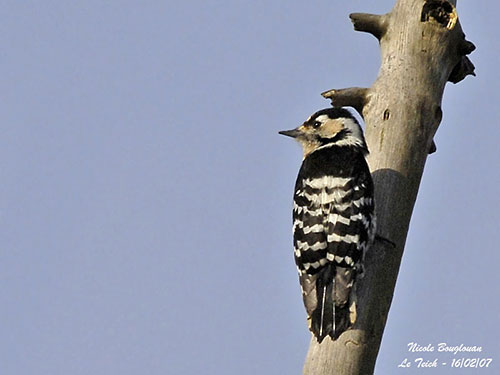
P. m. buturlini
Female
PROTECTION / THREATS / STATUS:
The Lesser Spotted Woodpecker is fairly common to scarce throughout the wide range.
The species is affected by the loss of deciduous habitats caused by conifer plantations. It is also sensitive to forest fragmentation in some parts of the range.
Europe forms 45% of the global range, and the European population is estimated at 983,000/2,110,000 mature individuals (2015). But more information is needed.
The European population is suspected to be stable, despite local declines caused by habitat loss.
But the species is not considered globally threatened, and the Lesser Spotted Woodpecker is currently evaluated as Least Concern.
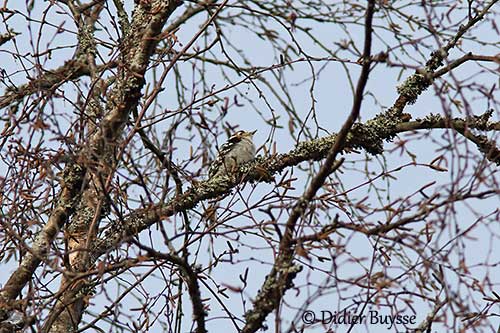
P. m. minor
Female
P. m. buturlini
Male
P. m. buturlini
Male at nest entrance